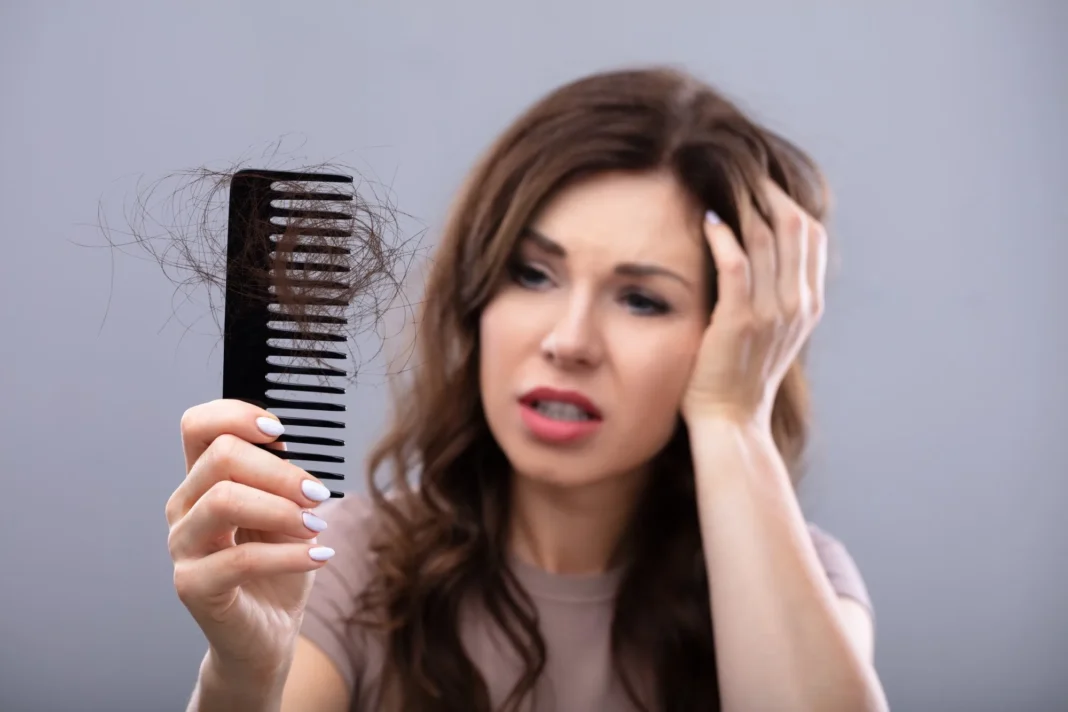Hair loss is a natural part of our body’s cycle, and on any given day, you may notice a few strands of hair on your brush, pillow, or in the shower. This often leads people to question, “How much hair fall is normal in a day?” Understanding the average rate of hair shedding can alleviate concerns and help identify when hair loss becomes excessive, which might require treatment. Let’s delve into the science behind hair shedding and what is considered a normal amount of hair loss.
The Hair Growth Cycle
Before understanding how much hair fall is normal, it’s important to comprehend the hair growth cycle. Hair goes through three main phases:
- Anagen (Growth Phase): This is the active growth phase that lasts 2-6 years. About 90% of the hairs on your scalp are in this phase at any given time.
- Catagen (Transitional Phase): This is a short, transitional phase that lasts for about 2-3 weeks, where the hair follicle starts to shrink.
- Telogen (Resting Phase): The resting phase lasts for around 3 months. At the end of this phase, the hair strand is shed and a new hair begins its growth in the anagen phase.
Given that different hair strands are in different phases at all times, daily hair shedding is entirely normal.
How Many Strands of Hair Fall in a Day is Normal?
On average, it is considered normal to shed about 50 to 100 strands of hair a day. The number can vary slightly from person to person depending on factors like age, gender, overall health, hair type, and daily hair care routine.
- Gender: Women typically shed more hair than men due to hormonal fluctuations and longer hair length, which may make shedding more noticeable.
- Seasonal Shedding: Many people experience increased hair shedding during certain times of the year, especially during autumn or after summer, which can contribute to a slight increase in daily hair loss.
- Hair Care: Aggressive brushing, tight hairstyles, and excessive heat styling can also accelerate hair shedding.
It’s important to remember that shedding hair is a sign that your hair follicles are going through their natural cycle and making way for new hair growth. However, if you start noticing significant hair loss beyond the typical 100 strands, it may be a sign of an underlying condition, such as stress, hormonal imbalance, or nutritional deficiencies.
When to Be Concerned About Hair Loss
Noticing a few extra strands on your hairbrush may not be a cause for alarm. However, if you find clumps of hair coming out, thinning areas, or patches of baldness, it could be an indicator of excessive hair loss. This is where the daily norm of 50-100 strands of hair loss becomes more concerning. Common causes of excessive hair loss include:
- Stress: High levels of physical or emotional stress can lead to telogen effluvium, a temporary hair loss condition where hair prematurely enters the resting phase.
- Hormonal Imbalances: Conditions like thyroid disorders or hormonal shifts due to pregnancy, menopause, or birth control use can trigger hair loss.
- Nutritional Deficiencies: A lack of essential nutrients like iron, zinc, or vitamins can cause the hair to thin and fall out.
- Medical Conditions: Alopecia areata, scalp infections, or autoimmune diseases are often linked to rapid hair loss.
If you notice prolonged periods of excessive hair loss, it’s best to consult with a specialist who can guide you toward the right course of action. Many options are available, such as hair loss treatments that cater to individual needs.
Hair Loss Treatment Options
If you’re losing more than 100 strands a day, especially over a long period, there are several treatments that can help slow the process, encourage regrowth, or maintain the existing hair on your scalp. Hair loss treatments vary based on the underlying cause of hair loss. For instance:
- Medications: Treatments like Minoxidil (Rogaine) and Finasteride (Propecia) are commonly prescribed for individuals experiencing hair thinning.
- Platelet-Rich Plasma (PRP) Therapy: A non-invasive procedure where platelet-rich plasma is injected into the scalp to promote hair growth.
- Low-Level Laser Therapy (LLLT): This treatment utilizes laser light to stimulate hair follicles and promote regrowth.
- Surgical Solutions: Hair transplant surgeries are effective for those with advanced hair loss. Techniques like Follicular Unit Extraction (FUE) can provide natural-looking results.
- Hair Loss Treatment in Islamabad: If you’re located in Pakistan, specialized hair loss treatment in Islamabad is available to provide tailored solutions for your hair concerns. Hair loss treatment in Islamabad offers a wide range of effective treatments, ensuring the best outcome for individuals struggling with hair thinning or excessive hair fall.
When to Seek Professional Help?
It is recommended to seek professional advice when you notice signs such as a receding hairline, thinning on the crown, or overall visible hair thinning. A consultation with a dermatologist or trichologist can help identify the root cause of your hair loss and provide a targeted treatment plan. The earlier you address hair loss, the better your chances of slowing down or reversing the process.
For individuals suffering from genetic hair loss, also known as androgenetic alopecia, or pattern baldness, early intervention is key. In such cases, treatments like hair transplantation, PRP therapy, or medications may be the best solutions to regain lost confidence.
Final Thoughts
Shedding around 50 to 100 strands of hair per day is normal and part of a healthy hair cycle. If you’re concerned about hair loss, it’s essential to first understand what’s normal for you and monitor any significant changes. Excessive hair shedding may require treatment, and fortunately, there are various effective options available today.
If you’re experiencing significant hair loss and want to explore treatments, hair loss treatment in Islamabad offers expert care tailored to individual needs. From medications to advanced hair restoration techniques, finding the right treatment early on can make a significant difference in managing hair loss.







